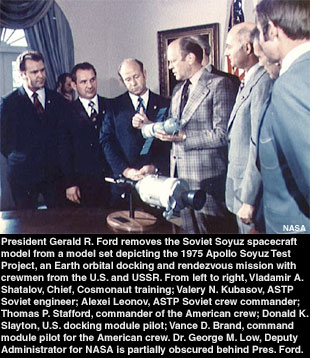|
|

|
Remembering Gerald Ford's space legacy

December 27, 2006 — He was only in the White House for 895 days but during that time he witnessed the first joint space mission between the United States and the Soviet Union, saw his nation land the first spacecraft on Mars and was there for the rollout of the first space shuttle. He may not have made major contributions to space policy as the President but earlier in his career as a member of the House of Representatives, he helped create NASA.
Gerald R. Ford, Jr., 38th President of the United States, died on Tuesday at age 93. Ford assumed the office in August 1974, following the resignation of Richard Nixon. In 1973, Nixon had appointed Ford to be his second in commmand after Vice President Spiro Agnew resigned.
As such, Ford was the only person in U.S. history to hold the two highest political posts without ever being elected to either.
Ford's two years as President fell between the end of the Apollo Program and beginning of the space shuttle era.
In July 1975, less than a year into his presidency, Ford witnessed the symbolic handshake in space between an American astronaut and Soviet cosmonaut during the Apollo-Soyuz mission.
"I had the pleasure and thrill of talking to our astronauts and the Soviet cosmonauts when they linked up in space at the culmination of the historic U.S.-U.S.S.R. Apollo Soyuz Test Project," Ford wrote in a report to Congress.
During the long distance telephone call, Ford questioned both nations' crewmen about their spacecraft's docking system, their training, asked for their advice for aspiring astronauts and inquired about space food. He began the conversation recognizing the precedent set by their flight.
"It has taken us many years to open this door to useful cooperation in space between our two countries and I am confident that the day is not far off when space missions made possible by this first joint effort will be more or less commonplace," Ford radioed to space.
One year later, on July 20, 1976, President Ford watched as the United States landed Viking I on Mars, making the first successful touchdown on the red planet's surface. A feat that was followed a month later by Viking II.
"I think it's amazing to think that in the span of a single lifetime, the exploration of air and space has grown from the dreams of a very, very few individuals to such a massive cooperative reality. We have gone from a flight of a few seconds and a few hundred feet for a year- long journey to Mars, crossing some 440 million miles," Ford told NASA Adminstrator Dr. James Fletcher and NASA's Viking Project Manager Jim Martin.
Viking I was originally scheduled to land on July 4, 1976, the United States' bicentennial, but was delayed in orbit while scientists sought a safe landing site. A signal sent by Viking on July 1 relayed to Washington, D.C. triggered a replica of the lander's arm to cut the opening ribbon of the Smithsonian's National Air and Space Museum. Ford, who was present for the ceremony, called the new facility "a perfect birthday present" for the nation.
Ford's Administration supported the continued funding for the space shuttle and he attended the September 1976 rollout of the first test orbiter, Enterprise. Originally to be named Constitution in another bicentennial nod, fans of the television show Star Trek sent thousands of letters to Ford urging it be named after the fictional starship. As a result, President Ford insisted NASA rename the orbiter.
Reports on space activities written by Ford in 1975 and 1976 hailed the on-going development of satellites and the data received from interplanetary probes as "a major contribution to our quality of life and economic growth."
Ford's contributions to the nation's space program largely were restricted to seeing the product of his predecessor's initiatives.
Prior to joining the Executive Branch however, Ford, the 24-year Michigan congressman, served on the committee that oversaw the transition to NASA from the National Advisory Committee on Aeronautics.
"Ever since I first came to the Congress I have had a great interest in science and technology. I recall very vividly my first exposure, as a member of the Committee on Appropriations, to military research and development programs. And subsequently, I had the opportunity to serve on the select committee that changed NACA to NASA, and subsequently became very interested in the space program itself," President Ford said in 1976. |

© 2023 collectSPACE.com All rights reserved.
Questions? E-mail contact@collectspace.com

|
|

|

|
